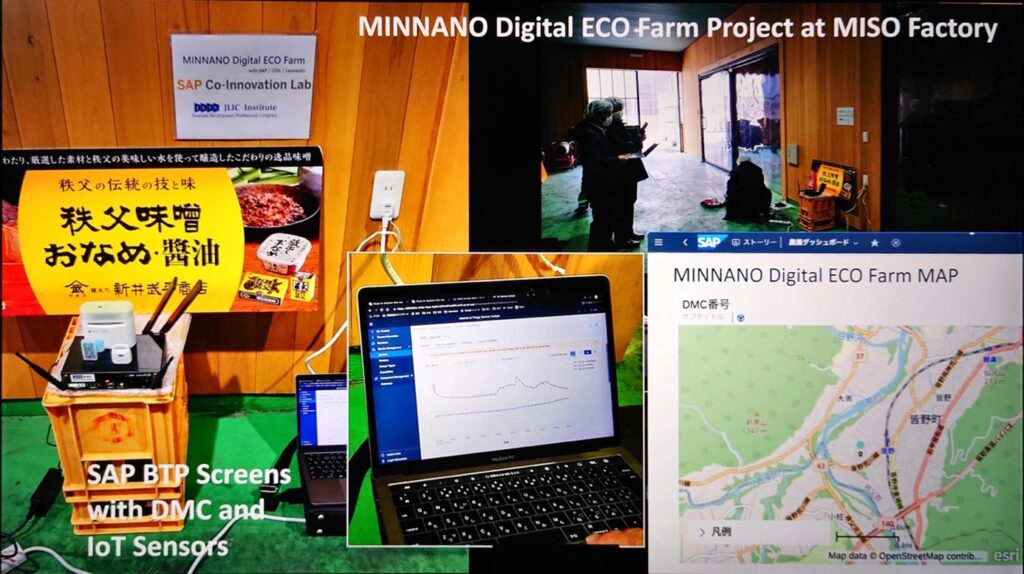With rural population in decline, many communities in the Japanese countryside struggle to continue farming and harvesting their land. SAP partner PSI and SAP Co-Innovation Lab in Japan launched a co-innovation project to help the town of Minano revitalize its community.
Like other industrial nations, Japan has been facing massive demographic challenges in its agriculture sector. An aging population and a lack of younger individuals entering the sector to replace them have led to farms being abandoned and fields lying fallow.
Japan’s government has realised the demographical issue, of course, as it touches not only the agricultural sector. To revitalise rural areas and stem the rural exodus, the government launched a national action plan.
In alignment with this action plan, SAP Japan has joined the effort of encouraging rural communities to thrive by launching a co-innovation project with PSI, an SAP partner, and the local government of the town of Minano.
Digitising the Agricultural Sector
The small town of Minano is located in the hills of Saitama Prefecture, about two hours from Tokyo. While the south of this prefecture is largely a suburb of the Tokyo area, the west, approaching Mt. Fuji, is still very rural and thinly populated. A former center of silk industry, the region on average is sunny and warm but can get lots of snow in winter.
“Farms in this area are traditionally small and dispersed, located between forests and mountains,” says Yoshihisa Horiguchi, chairman of MINNANO Future Create. “Big supermarkets and retailers overlook them. Nowadays, the farmers cultivate rice and vegetables in small amounts to consume themselves, sell to their neighbours, or send to their children or grandchildren that live in cities.”
Since 1950, Minano has lost roughly one-third of its population, largely due to the decline of the agricultural sector. Today, it counts about 10,000 inhabitants.
“Young people often migrate to urban areas for better education and employment opportunities,” Horiguchi explains. “Where 50 years ago, a farm may have relied on 20 young workers, now only two elderly workers are left.”
Digitisation is one obvious approach that may help prevent those areas from depopulating completely.
“But while large-scale farms benefit from the economic feasibility of applying robotics and the like, it is financially and logistically challenging to apply such technologies to small-scale dispersed farms,” Horiguchi says.
Horiguchi, the owner of an automotive parts manufacturing company, co-founded the local initiative MINNANO Future Create in 2019 to solve the challenges resulting from population loss. Its members range from elderly individuals to young residents, forming a diverse group of individuals, including pharmacists, architectural designers, and other professions, all living in the town.
For one of its projects, the Minano Digital Eco Farm, it partnered with SAP Co-Innovation Lab.
IoT Solution for Monitoring Agriculture
The Minano Digital Eco Farm project aims to build a communication platform that connects farmers and urban residents as well as small-scale dispersed farms to major supply chains, forming a portfolio that coexists with existing large-scale farms. In alignment with the United Nations’ Sustainable Development Goals (SDGs), the project will help overcome supply chain disruptions due to food shortages and crop failures due to abnormal weather, conflicts, disasters, and more.
For this vision to become a reality, Internet of Things (IoT) sensors were distributed in various locations and managed remotely from headquarters.
“The idea was to have an IoT solution running on SAP Business Technology Platform (SAP BTP) that would help monitor all the agricultural processes,” says Atsushi Minakuchi, senior solution specialist at SAP Co-Innovation Lab in Japan.
SAP Co-Innovation Lab partnered with PSI, which brought in the Digital Material Controller (DMC), an all-in-one compact edge controlling server that enables easy setup of a ubiquitous IoT environment. And, due to the cooperation with SAP Co-Innovation Lab, the DMC has also obtained SAP certification.
“Many IoT sensors lack cybersecurity functions,” Mitsuhiro Yamazaki, senior advisor and former president of PSI, says. “However, by connecting sensors to a DMC with cybersecurity capabilities, it becomes possible to securely store locally collected data on the DMC, safely transmit to SAP BTP, and accumulate, analyze, and utilize data from the DMC. This enables seamless and easy integration between the SAP core system and the IoT system.”
“Collaboration with SAP Co-Innovation Lab has significantly expanded the application possibilities of DMC,” Masaki Fukui, former PSI Cyber Security Lab director and now with the Ministry of Internal Affairs and Communication, says. “Global users of SAP now could have the opportunity to easily implement and utilize a ubiquitous supply chain platform through the combination of DMC and SAP BTP.”
Through integration with SAP BTP, the deployment locations can then be displayed and monitored on a dashboard.
The idea is for citizens living in the city to enter a service contract with a rural farm or supplier and to connect via a technology platform to remotely monitor and support agricultural processes. In return, they receive part of the crops – freshly delivered to their homes in the city.
So far, two proofs of concept for farms have been completed between March 2019 and November 2022, as well as one proof of concept for a miso factory. Agriculture and rural industry are only two fields of application. Future projects could include schools, hospitals, stores, and elder care facilities.

Strengthening Rural Appeal for Inland Tourism
As a corporate social responsibility project, the Minano Digital Eco Farm came to life through the voluntary engagement of SAP employees in Japan who supported the project on top of their regular work.
The project is supported by a government program unique for Japan, the so-called hometown tax payment, which makes it possible for citizens to choose and support the region they were born and raised in or a community they wish to engage with.
“The possibility of hometown tax payment is very popular among Japanese people,” Hidenori Kurosawa, vice governor of Minano, explains. “To us in rural regions, it seems that this played a significant role in creating an interest in the countryside. People want to get to know and support local towns.”
Indeed, the appeal of small, thinly populated communities surrounded by beautiful forest landscape hasn’t gone unnoticed by Japanese inland tourists.
Kurosawa says: “We wish to make Minano appealing to visitors by offering return gifts that provide an experience – that allow visitors to come to the town, interact with the locals, and experience things that are unique to this place.”
The Minano Digital Eco Farm project aligns well with this strategy. Not only does it promote Minano’s charm but, by expanding initiatives, it addresses local challenges such as reclamation of abandoned farmland, increased self-sufficiency in food, reduction of CO2 emissions, and improved profitability in agriculture.
“We have great expectations that this initiative will contribute to addressing the town’s challenges and advancing the UN SDGs,” Kurosawa states. “We express our sincere gratitude to the volunteers from SAP Japan who provided invaluable assistance in bringing the Minano Digital Eco Farm project to life.”
“MINNANO” means “for everyone” in Japanese and is pronounced the same way as the name of the town. Fukui from the Ministry of Internal Affairs and Communication explains the idea behind that name: “One action can have multiple meaningful impacts. The issue of unseen small-scale dispersed farms facing economic challenges can be witnessed around the globe. By collaborating with SAP, we hope to inspire rural communities beyond our own prefecture, maybe even beyond Japan.”



